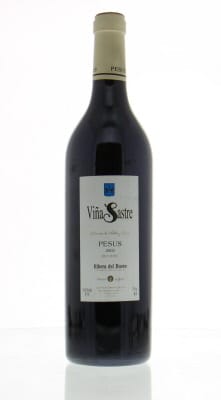Ribera del Duero
In decades Ribera del Duero has emerged as a wine region with a rich history of winemaking. The influence of monks who arrived in the 12th century has played a significant role, in shaping the traditional techniques still practiced today. Some of the most legendary wines from Spain come from Ribera del Duero.
The best wines from Ribera del Duero
In decades Ribera del Duero has emerged as a wine region with a rich history of winemaking. The influence of monks who arrived in the 12th century has played a significant role, in shaping the traditional techniques still practiced today. Some of the most legendary wines from Spain come from Ribera del Duero.
An integral part of Ribera del Dueros identity is its winery Vega Sicilia. Spain's most legendary winery was founded by Don Eloy Lecanda in 1864. Vega Sicilia quickly established a great reputation for its full-bodied, rich wines from Bordeaux varieties combined with the local tinto fino.
From the 1980s onwards a wave of winemakers flocked to the region, including Danish vintner Peter Sisseck, who founded Dominio Pingus in 1995. The first vintage of his wine attracted the attention of the international wine press. Since then Peter Sisseck's iconic wine Pingus has reached a cult status.
Grapes in wines from Ribera del Duero
Other regions
Tinto Fino
Ribera del Duero is known for its most important grape, the Tinto Fino, also known as Tinta del País, a local variety of the Tempranillo grape. This grape is recommended for replanting throughout the region because of its ability to produce fine, complex wines here without the support of other varieties. Unlike Rioja, where this grape is often blended. The Tinto Fino thrives there as a monoculture thanks to the region's altitude and soils.
The terroir of Ribera del Duero
Ribera del Duero experiences dry summers and intense winters, which allows for gradual ripening of grapes, resulting in the production of high-quality wines. Due to the of continental and Mediterranean influences, Vineyards experiences high daytime temperatures of up to 40°C, dropping to 15°C at night. These temperature variations positively affect the grapes' absorption of nutrients and acidity. The diverse soil types in the area contribute to the variety of wine styles and qualities, especially away from the river locations, where the soils are sandy and lay on top of limestone layers.
The region's wines are full, ripe and generally have a substantial alcohol percentage, but also a good acidity that ensures finesse and a good balance. Perhaps most important for the quality of Ribera wines is the diurnal range during the growing season. Due to the location of the vineyards between 720 to 1,100 meters above sea level on the Spanish mountain plateau "Meseta Central", temperatures drop dramatically at night. Therefore, the grapes hold on to their acidity that you'll taste in the wines.
Ribera del Duero's area is characterised as a vast, level terrain following the river Douro, However, the soils vary significantly based on altitude. The vineyards span from the river valley to the mountain peaks, often structured in terraces. The lower areas, like riverbanks and lower lands, are termed as "campiñas" or "terrazas." The less steep slopes, referred to as "laderas", are optimal for vine cultivation, while the 'cuestas' or steep slopes are unsuitable for planting. The highest terrains, known as "páramo", are more conducive to growing grains due to intense solar radiation.
The climate here is less moderate than in Rioja, and therefore has more extremes. The locals themselves describe the climate as “9 months of winter, 3 months of hell”. The number of sun hours is 2,400 per year. Summer days are hot and in winter temperatures easily drop to -20 °C and lower.
The classifications of Ribera del Duero wines
The Denominación de Origen (DO) status, bestowed in 1982 due to the high-quality viticulture at Vega Sicilia, spans across the provinces of Burgos, Soria, Segovia, and Valladolid, primarily between 750 and 850 meters above sea level. The terroir is markedly different. But other than that, the areas are much alike, for instance, they use the same classifications, and here too, wines are made that need a long maturation. These are the different classifications:
- Joven - no or only minimal (oak) maturation
- Crianza - maturations for at least two years, of which at least one year in oak barrels
- Reserva - maturations for at least three years, of which at least one year in oak barrels
- Gran reserva - maturations for at least five years of which at least two years in oak bareels
- Gran reserva wines are particularly layered and complex wines whose profile and build resemble the old tino fino vines from which they originate: knotty, powerful, earthy with intensely dark notes of chocolate, tobacco and leather.
Some of the best wine producers in Ribera del Duero
That is a matter of taste and sometimes changes with time. The following producers are definitely among the best in Ribera del Duero:
The best vintages in Ribera del Duero
The best vintages of the last 60 years are: 1968, 1990, 1994, 1995, 2001, 2004, 2005, 2010, 2016, 2020.






